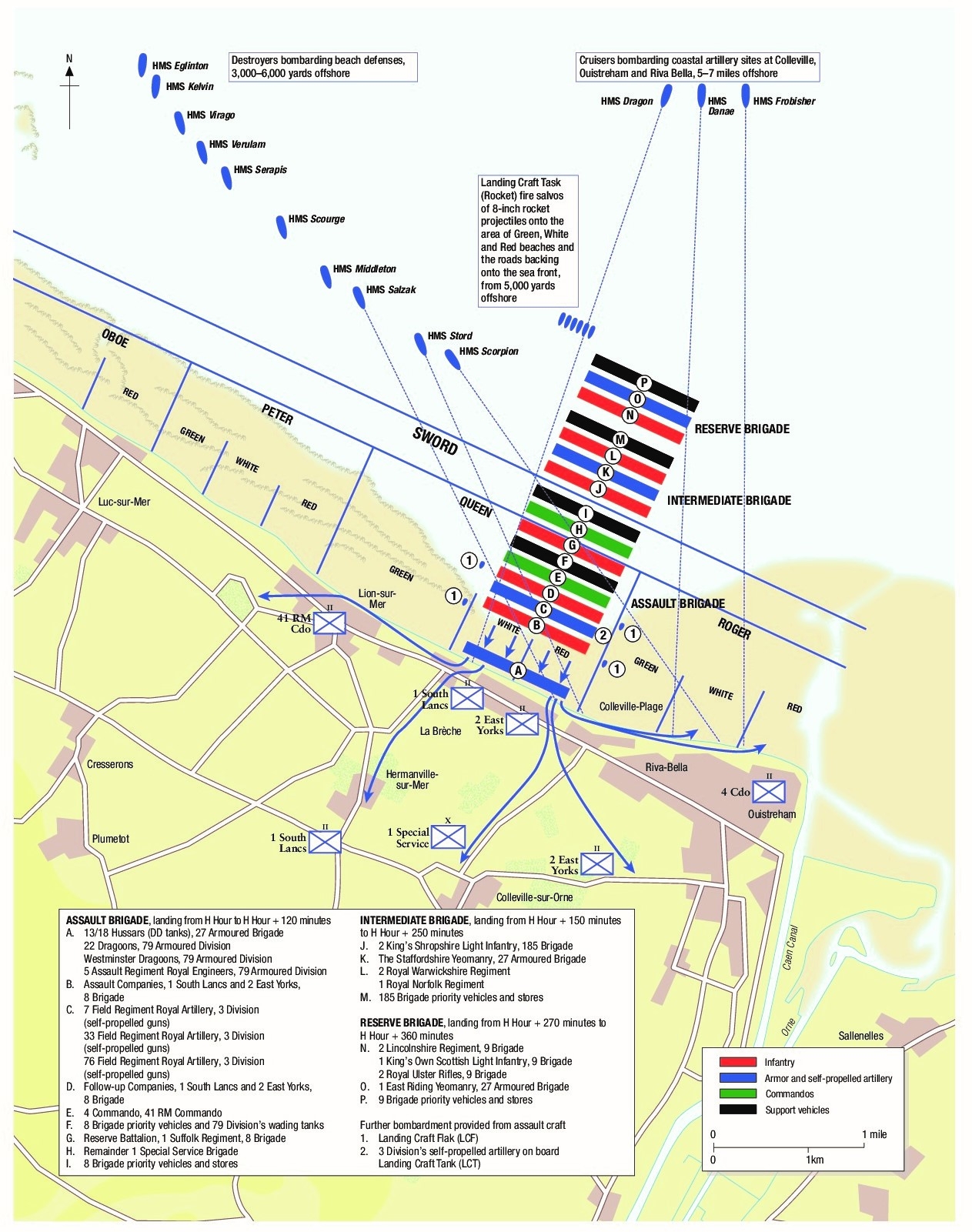Today is the 75th Anniversary of the D-Day landings. To commemorate this anniversary of the landings, we look at the key assaults that occurred that day using a few extracts from Steven Zaloga’s Atlas of the European Campaigns 1944-45.
This blog post examines the events on Sword Beach.
"The assault by the 8th Brigade, 3rd Infantry Division on Sword Beach was somewhat similar to the US 4th Infantry Division at Utah Beach, landing along a fairly narrow corridor only two battalions wide but thereby concentrating the entire force against a single strongpoint. The 1st South Lancs landed west of WN20 in La Breche, codenamed “Cod.” This strongpoint included a 75mm PaK 40 in an H677 enfilade bunker as well as three 50mm pedestal guns. At the same time, the neighboring 2nd East Yorks landed on its eastern side. The gun bunkers took a toll on tanks assisting the 2nd East Yorks, knocking out many Sherman flail tanks as they attempted to clear paths off the beach. The British infantry moved over the beach as quickly as possible to avoid the heavy fire against the shoreline. After the wire entanglements were breached, Cod was assaulted by elements of both battalions supported by DD tanks from the 13th/18th Hussars and was overcome shortly after 1000hrs after nearly 3 hours of fighting. By H+60, the follow-on waves began to arrive. The defenses in the center portion of Sword Beach had largely been eliminated once Cod was overwhelmed, but the beach remained under fire from scattered snipers, and from mortars and artillery located away from the beach. The German defensive positions on either side of the 8th Brigade were assigned to commando units.
In another parallel to the landings on the American beaches and the assault by the Rangers on Pointe du Hoc, the task of silencing the artillery batteries at the extreme eastern side of Sword Beach was assigned to 4 Commando. The battalion landed away from the defenses, and advanced along the road eastward to attack the defensive positions from the land side. Two French troops from 10 Commando were attached to 4 Commando, and led the attack on WN10. The lightly armed French commandos had a hard time dealing with the numerous defenses, which included a 75mm field gun in an H626 bunker, and the attack stalled. By this time, Sherman tanks from the neighboring 8th Brigade had arrived near Ouistreham, and a DD tank was dispatched to assist in the commando assault. Once the WN10 defenses were overcome with the help of tank fire, 4 Commando proceeded to assault the artillery battery in Stützpunkt 08 in Riva Bella. This strongpoint was dominated by a multistory observation tower at the far end. As the commandos fought past an outer ring of Tobruk pits and other defenses into the heart of the battery positions, they realized that the Germans had withdrawn the guns owing to the preinvasion bombardment, much as had occurred at Pointe du Hoc. German troops continued to hurl grenades from the observation tower, but, rather than waste time and lives to capture the structure, 4 Commando left the tower for clean-up by follow-on troops.
To the west, 41 Royal Marine Commando assaulted the WN21 (Trout) strongpoint in Lion-sur-Mer, which included a single 75mm field gun and two pedestal-mounted 50mm guns in open pits. The WN21 strongpoint was found to be deserted, but the neighboring château proved more difficult, and 41 Royal Marine Commando was unable to proceed to its secondary objective (the Luftwaffe radar station at Douvres-la-Délivrande) with the help of tanks from the 5th Assault Regiment, Royal Engineers.
With the defenses on Sword Beach thoroughly penetrated, albeit not entirely subdued, the follow-on waves moved off the beaches to carry out their further objectives. The 185th Brigade proceeded through Colleville-Plage on their way to Caen, encountering two major fortified areas in the process, an artillery battery in the WN16 strongpoint codenamed Morris, and the heavily fortified headquarters complex of Grenadier-Regiment.736 in strongpoint WN17, codenamed Hillman. The 1st Suffolks overwhelmed the artillery battery at WN16 and then proceeded to the Hillman complex. WN17 was encircled by minefields and barbed wire, and the British infantry fought its way into the strongpoint after breaching the wire. The personnel bunkers inside the strongpoint were the heavy bombproof type as used on the Westwall,
and not the more vulnerable Tobruk type common elsewhere on the D-Day beaches. As a result, the 1st Suffolks brought up some 17-pdr antitank guns, attempting to crack open the bunkers by blasting their armored cupolas. There were so many bunkers and firing ports that it took the 1st Suffolks the entire day to overwhelm the headquarters, finally eliminating resistance at 2015hrs that evening. Although casualties in the 1st Suffolks were not particularly heavy from the attack on Hillman, during the afternoon the 1st Royal Norfolks unwarily marched through a field within range of Hillman, and suffered about 150 casualties from machine-gun fire from the strongpoint. The prolonged resistance by the WN17 strongpoint, as well as the later counterattack by elements of the 21.Panzer-Division, were some of the reasons that 185th Brigade was unable to press on to its intended objective that day, the city of Caen."
- Steven Zaloga, Atlas of the European Campaigns 1944-45, page 58
To find out more about D-Day, head to the blog and order your copy of Atlas of the European Campaigns 1944-45.



Comments
You must be logged in to comment on this post. Click here to log in.
Submit your comment